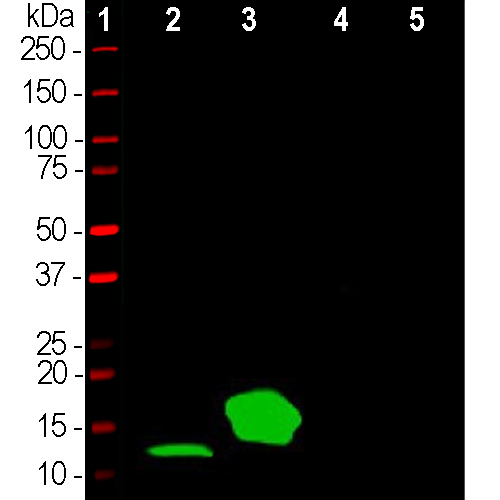| Name: | Chicken Polyclonal to Parvalbumin |
| Immunogen: | Full-length recombinant human protein expressed in and purified from E. coli. |
| HGNC Name: | PVALB |
| UniProt: | P20472 |
| Molecular Weight: | 12kDa |
| Host: | Chicken |
| Isotype: | |
| Species Cross-Reactivity: | Human, Rat, Mouse |
| RRID: | AB_2572371 |
| Format: | Concentrated IgY preparation in PBS plus 0.02% NaN3 |
| Applications: | WB, IF/ICC, IHC |
| Recommended Dilutions: | WB: 1:1,000-1:5,000 IF/ICC, IHC: 1:2,000 |
| Storage: | Store at 4°C |

Immunofluorescent analysis of a rat cerebellum section stained with chicken pAb to parvalbumin, CPCA-Pvalb, dilution 1:2,000, in green, and costained with mouse mAb to GFAP, MCA-2A5, dilution 1:500, in red. The blue is DAPI staining of nuclear DNA. Following transcardial perfusion of rat with 4% paraformaldehyde, brain was post fixed for 24 hours, cut to 45μM, and free floating sections were stained with above antibodies. The CPCA-Pvalb antibody labels the perikarya and dendrites of Purkinje cells and interneurons in the molecular layer of the cerebellum. The GFAP antibody stains the processes of Bergmann glia and astrocytes.

Western blot analysis of skeletal muscle lysates and His-tagged recombinant human proteins using chicken pAb to parvalbumin, CPCA-Pvalb, dilution 1:2,000, in green: [1] protein standard (red), [2] mouse muscle, [3] recombinant full length human parvalbumin, [4] recombinant full length human calretinin and [5] recombinant full length human calbindin. Band at 12kDa in muscle lysate is native parvalbumin and 18kDa band in the next lane is His-tagged recombinant parvalbumin. The CPCA-Pvalb antibody binds parvalbumin strongly but is not cross-reactive with the related calcium binding proteins calretinin and calbindin.
Chicken Polyclonal Antibody to Parvalbumin
Cat# CPCA-Pvalb
$120.00 – $800.00
Parvalbumin is a low molecular weight cytoplasmic Calcium binding protein containing the “EF hand” Calcium binding motif and is the first protein characterized in this subclass (1). Parvalbumin is expressed in fast-contracting muscles, in the brain and in some endocrine tissues (2,3). In brain it is particularly concentrated in Purkinje cells and interneurons in the molecular layer, but is also found in many cortical GABAergic interneurons. These GABAergic interneurons in most cases express only one of three Calcium binding proteins, namely parvalbumin, calretinin or calbindin (4-6). Each type of interneuron has distinct electrophysiological properties and as a result, different types of interneuron can be identified and classified based on their content of these three proteins (7).
The CPCA-Pvalb antibody was made against full length recombinant human parvalbumin expressed in and purified from E. coli. Since parvalbumin is related in amino acid sequence to both calretinin and calbindin, we also expressed these proteins to check that our various reagents show no cross reactivity. So our antibodies to parvalbumin are useful cell type markers provided, as is the case with this antibody, they do no cross react with the related molecules calretinin or calbindin. EnCor also manufactures a mouse monoclonal antibody to parvalbumin MCA-3C9. We also supply a variety of other mouse, rabbit and chicken antibodies to calbindin (MCA-5A9 and CPCA-Calb) and calretinin (MCA-3G9, MCA-6A9, RPCA-Calret and CPCA-Calret), allowing double and triple labeling of appropriate cell and tissue samples. Mouse select image at left for larger view.
Chromogenic immunostaining of a formalin fixed paraffin embedded rat cerebellum with chicken pAb to parvalbumin, CPCA-Pvalb, dilution 1:2,000, detected in DAB (brown) following the ABC method. Hematoxylin (blue) was used as the counterstain. Parvalbumin antibody detects perikarya and dendrites of Purkinje cells and interneurons throughout the molecular layer of the cerebellum. Mouse select image for larger view.
1. Kretsinger RH, Nockolds CE. Carp Muscle Calcium-binding Protein: II. Structure determination and general description. J. Biol. Chem. 248:3313-26 (1973).
2. Andressen C, Bliimcke I, Celio MR. Calcium-binding proteins: selective markers of nerve cells. Cell Tissue Res. 271:181-208 (1993).
3. Schwaller B, Meyer M, Schiffmann S. ‘New’ functions for ‘old’ proteins: The role of the calcium binding proteins calbindin D-28k, calretinin and parvalbumin, in cerebellar physiology. Studies with knockout mice. The Cerebellum 1:241–58 (2002).
4. Celio MR. Calbindin D-28k and parvalbumin in the rat nervous system. Neurosci. 35:375-475 (1990).
5. Condé F, et al. Local circuit neurons immunoreactive for calretinin, calbindin D‐28k or parvalbumin in monkey prefronatal cortex: Distribution and morphology. J. Comp. Neurol. 341:95-116 (1994).
6. Hof PR, et al. Cellular distribution of the calcium-binding proteins parvalbumin, calbindin, and calretinin in the neocortex of mammals: phylogenetic and developmental patterns. J. Chem. Neuroanat. 16:77-116 (1999).
7. Bearzatto B, et al. Mono- and dual-frequency fast cerebellar oscillation in mice lacking parvalbumin and/or calbindin D-28k. Eur. J. Neurosci. 22:861-70 (2005).
Related products
-

Chicken Polyclonal Antibody to CNP
$120.00 – $800.00
Cat# CPCA-CNPSelect options This product has multiple variants. The options may be chosen on the product page -

Chicken Polyclonal Antibody to ACIII
$150.00 – $1,000.00
Cat# CPCA-ACIIISelect options This product has multiple variants. The options may be chosen on the product page -

Chicken Polyclonal Antibody to MeCP2
$120.00 – $800.00
Cat# CPCA-MeCP2Select options This product has multiple variants. The options may be chosen on the product page -

Chicken Polyclonal Antibody to Calretinin
$120.00 – $800.00
Cat# CPCA-CalretSelect options This product has multiple variants. The options may be chosen on the product page
Contact info
EnCor Biotechnology Inc.
4949 SW 41st Boulevard, Ste 40
Gainesville
Florida 32608 USA
Phone: (352) 372 7022
Fax: (352) 372 7066
E-mail: [email protected]



